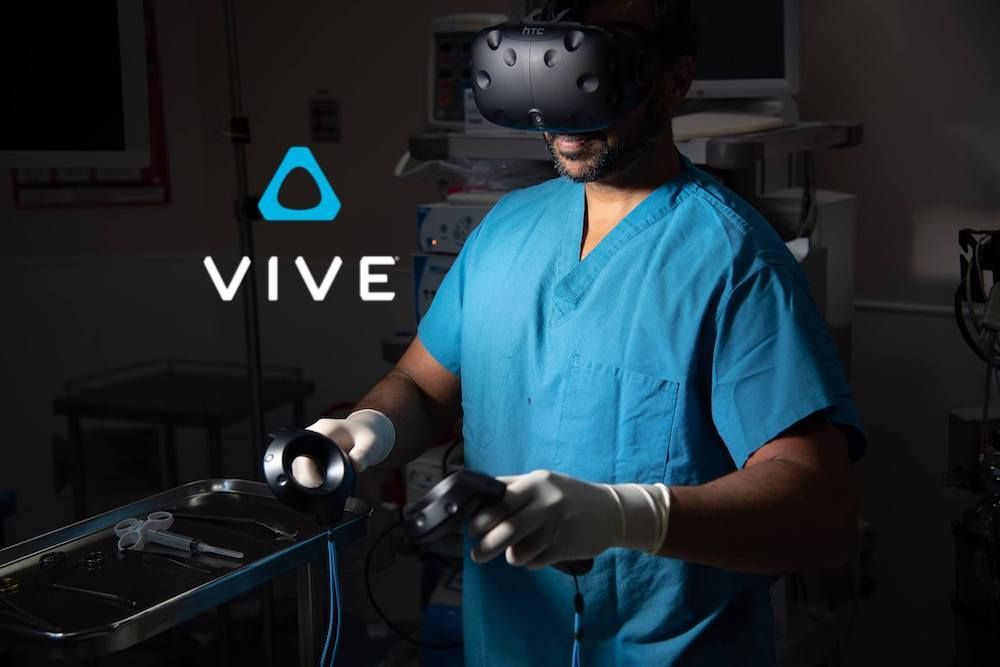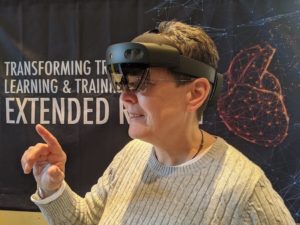HTC Vive
HTC Vive is designing Virtual Reality (VR) to enable healthcare organizations to provide the next generation of professionals with the tools they need to meet the demands of 21st-century healthcare education. For decades, healthcare organizations, universities, and hospitals have used simulations to provide students with risk-free, hands-on environments to hone their skills. Recently, these organizations have begun expanding beyond physical simulations to include virtual reality.
As the use of virtual simulation across healthcare increases, many facilitators have begun to incorporate the use of virtual reality (VR) headsets into learning experiences. Following the launch of the Meta Quest 2 and Meta Quest Pro, the company HTC recently launched the Vive XR Elite at CES 2023.
This VR and Mixed Reality (MR) headset includes a number of features that help create remarkable realism, such as a 4K display, a 110-degree field of view (FOV), and a 9OHz refresh rate. This HealthySimulation.com article shares more about this VR headset and discusses how the technology can be used to advance clinical simulation.
Sponsored Content:
Why Consider or Choose Virtual Reality?
VR simulations afford organizations with benefits like:
- Reduced education costs: Educators can replace dedicated rooms housing expensive
- specialized equipment with VR headsets and computers, decreasing overhead on disposable training tools, reducing the time needed to reset simulations, and eliminating other expenses.
- More accessible training: Many VR headsets don’t need a computer to provide practical training simulations, meaning students can train anywhere, anytime.
- Better training outcomes: Several studies report that VR Medical simulations improve learning ability and increase accuracy in actual medical practice.
There is no one-size-fits-all solution for designing for healthcare scenarios, so remember the following tips to ensure your product is as accessible as possible. So, how can a healthcare simulationist determine what equipment is needed, is best to meet their program’s needs, and how to systematically approach finding the best solution. One solution is to visit other healthcare simulation centers. During the visit, assess what equipment is used, what they identify as a need or equipment missing, and learn from their experience.
Lance Baily, Founder & CEO of HealthySimulation.com, states, “Even going to a few other simulation centers will give you so much knowledge in terms of how the operations work and what people do there. Such visits will help you explain to your administrators how your clinical simulation program compares to others – the size and scope, the staff, how much equipment they use, and the types of outcomes they get.”
Sponsored Content:
Investing in the Right VR Headsets
Nicole Brown, Education Specialist Cleveland Clinic, states, “We attempted to use a cheaper headset when we first started, but we found out pretty quickly that our healthcare organization had substantially increased its cybersecurity protocols. That’s when we landed on the HTC VIVE.”
Kurt Kratchman, CEO Virti (XR/VR) states, “One of the hidden surprises that people miss is that they often go for buying cheap headsets instead of the right ones. That’s why we have deliberately chosen to partner with HTC at the product and commercial level because their approach to security is just as high as ours. Their headsets are manufactured in TAA-designated areas, which means it’s all kosher by the U.S. government.”
VR is very good at helping students learn soft skills like memorizing procedures and learning communication skills. While VR can teach hard skills, these solutions require high-powered and potentially expensive haptic feedback technology to be truly effective. VR training will not fully replace physical, real-world training but what VR can do is provide easier access to randomized scenarios, allow training opportunities for rare, high risk situations, and supplement current training solutions. By providing more accessible ways to practice techniques, students and educators can maximize the time and money spent on more expensive non-VR training scenarios. In the selection of VR, an important aspect to consider is the user interface (UI) friction to improve immersion. If a learner has technical difficulties with connection or utilization of the VR, then the learner’s ability to become fully immersed in the experiential learning opportunity is hampered. Select the VR system with the highest level of realism, immersion, and user interfaces to ensure educators and students have smooth experiences.
About HTC VIVE
HTC VIVE is the premier virtual reality (VR) platform and ecosystem that creates true-to-life VR experiences for businesses and consumers. The VIVE ecosystem is built around premium VR hardware, software, and content. The VIVE business encompasses best-in-class XR hardware; Software; Business Device Management System (DMS), Location Based Software Suite (LBSS), VIVE Business Streaming (VBS) and VIVE Business Training (VBT) for business customers.
HTC VIVE gives professionals an unparalleled, true-to-life virtual reality experience. Using a headset and wireless controllers, clinical learners can explore and interact with VR experiences, apps and games that blur the line between imagination and reality. From AAA games to unforgettable experiences, there are over 2500 apps and games available for VIVE. Their VIVE XR Elite headset was the “Most awarded VR headset of CES and MWC 2023”, and provides a powerful, convertible, and lightweight headset that conforms to the wearer. Users can enjoy untethered freedom of all-in-one XR or harness the power of PC VR.
Virtual Reality hardware provider HTC Vive has recently collaborated with HealthySimulation.com on creating several key resources for healthcare professionals considering the use of VR in clinical education and training. By sharing these open access video podcasts with industry experts, helpful eBooks covering proven use cases, and insightful national survey results, HTC Vive demonstrates the potential of Virtual Reality to forever change the face of clinical education and training, as well as provide helpful strategies and tactics for those looking to deploy these innovative technologies.
HTC Vive Original Series: The Practicality of VR in Standardizing Clinical Training
In episode 4 of the Practicality of VR series, guest hosted by HealthySimulation.com CEO Lance Baily, HTC Vive explores the practical applications of virtual reality (VR) in clinical practice. Joining Lance are Virti CEO Kurt Krachman CEO, HTC Vive’s Head of Medical VR Lewis Chang, and Brigham and Women’s Hospital’s Associate Chief Medical Information Officer and President of the new AMXRA, Dr. Haipeng (Mark) Zhang, DO, MMSc, FAMIA.
The heightened healthcare demands of the 21st century requires a bold new approach to education and simulation design. VR is rapidly becoming a crucial tool for training the upcoming generation of medical practitioners by providing complex and repeatable scenarios at a greater scale and lower costs.
As a XR solution provider, the HTC Vive team understands that finding success within the healthcare industry requires a keen understanding of the unique needs of students and the security demands of its organizations. HTC Vive compiled a list of best practices provided by business owners currently working in this space and specialists actively employing these solutions to provide clinical educators with the necessary insight to make your simulation as successful as possible.
Download your free copy of the HTC Vive XR Training Solutions for Healthcare eBook here! From the ebook, clinical simulation champions will learn valuable lessons provided by VR solution developers and medical professionals, including:
The State of Virtual Reality Training in Healthcare – Key Survey Results
A 2023 HTC Vive survey on the State of Virtual Reality Training in Healthcare throughout the U.S. explored the current role and common perceptions of virtual reality training in healthcare. The headline result from over 400 participants? A staggering 91.24% of respondents believe that Virtual Reality enhances education plans and empowers coordinators to be more effective in their roles.
For healthcare organizations that have already adopted VR training, 84% of respondents involved with the VR purchase process say they “like” or “love” the VR training deployments they’ve already approved. 85.79% of respondents whose organizations have not yet adopted VR training believe they will do so by 2026 at the latest.
Meanwhile, the benefits of VR training in a healthcare setting extend far beyond executive decision-makers to every level of the business. More than four in five respondents believed that investment in VR made their facility attractive to top-tier talent, and more than four in five also believed that the investment made their facility more appealing to patients.
Furthermore, the results of the HTC Vive survey indicate that virtual reality training in a healthcare setting:
- Removes bottlenecks associated with traditional training techniques.
- Reduces the need to divert expensive equipment and supplies away from patient use in order to familiarize staff with their use.
- Is easy to set up and integrate into existing training programs.
More About HTC Vive VR Headsets
HTC VIVE gives professionals an unparalleled, true-to-life virtual reality experience. Using a headset and wireless controllers, clinical learners can explore and interact with VR experiences, apps and games that blur the line between imagination and reality. From AAA games to unforgettable experiences, there are over 2500 apps and games available for VIVE. Their VIVE XR Elite headset was the “Most awarded VR headset of CES and MWC 2023”, and provides a powerful, convertible, and lightweight headset that conforms to the wearer. Users can enjoy untethered freedom of all-in-one XR or harness the power of PC VR.
With the XR Elite, users can blend physical and virtual worlds and expand play with new possibilities. The headset features vibrant graphics and high-resolution passthrough with PC VR capability, so users can game, create, connect, and explore where realities intertwine. The sleep, compact headset is portable and comes with an adjustable IPD.
VIVE XR Elite also includes a full-color RGB passthrough camera, and hand-tracking, which enables a whole new dimension of MR scenarios. HTC notes that this can include “playing games where the characters are running on [the] furniture, having real-time overlays on musical instruments like a piano so you can learn, and even having the ultimate workstation with multiple virtual screens while still being able to use your real-world keyboard and mouse.”
Features of HTC Headsets
The VR product comes with diopter dials for the most natural and clearest visual experience. Further, the features of the headset enable high-octane PC VR gaming through wireless streaming. According to HPC, the product offers accurate tracking and spatial awareness in varied light conditions. Users can also connect the headset to their PC with a cable or Wi-Fi 6E and enjoy low-latency, high-fidelity PC VR gaming. Skeletal-level hand tracking enables intuitive interactions using just hands. Then users can navigate, click, drag, scroll, and type with natural hand and finger movements.
Upon putting the headset on, users enter the VIVERSE and are ready for immersive adventures with crisp, immersive audio. HPC states that VIVERSE continues to demonstrate leadership in supporting open standards and is accessible from a wide range of connected devices that support a web browser. The company has partnered with the leading Japanese creator platform pixiv to Integrate VRoid’s Anime-Style Avatars into VIVERSE, which makes bringing avatars into VIVERSE leveraging the open VRM standard easy.
Overall, the Vive XR Elite presents new ways to excel where physical and virtual worlds merge. For example, Virtual Desk reinvents how users create, multi-task, and communicate.
Latest HTC News

HTC VIVE Survey Results of Current Role of XR in Healthcare
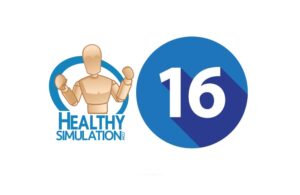
16 Must-Know Healthcare Simulation Key Terms
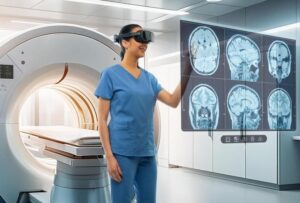
HTC VIVE Shares Tips and Tricks for Deploying VR in Hospital Settings
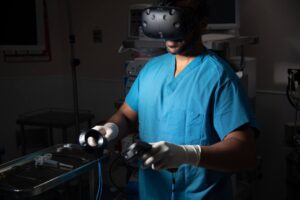
HTC VIVE: How Healthcare Training is Becoming More Accessible with XR
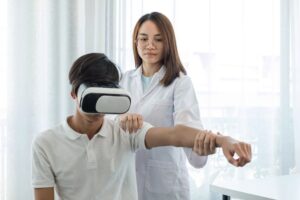
Using Virtual Reality for Physical Therapy Simulation Training
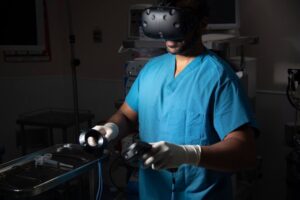
HTC Vive Designs Virtual Training Solutions for Healthcare
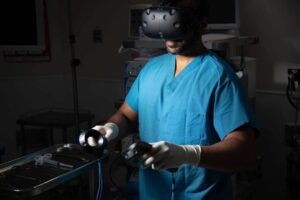
HTC Vive Shares Helpful Resources on Use of Virtual Reality in Healthcare Simulation
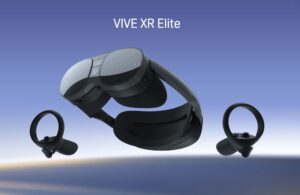
HTC’s New Standalone VIVE XR Elite Headset Harnesses Power of VR
Sponsored Content:



